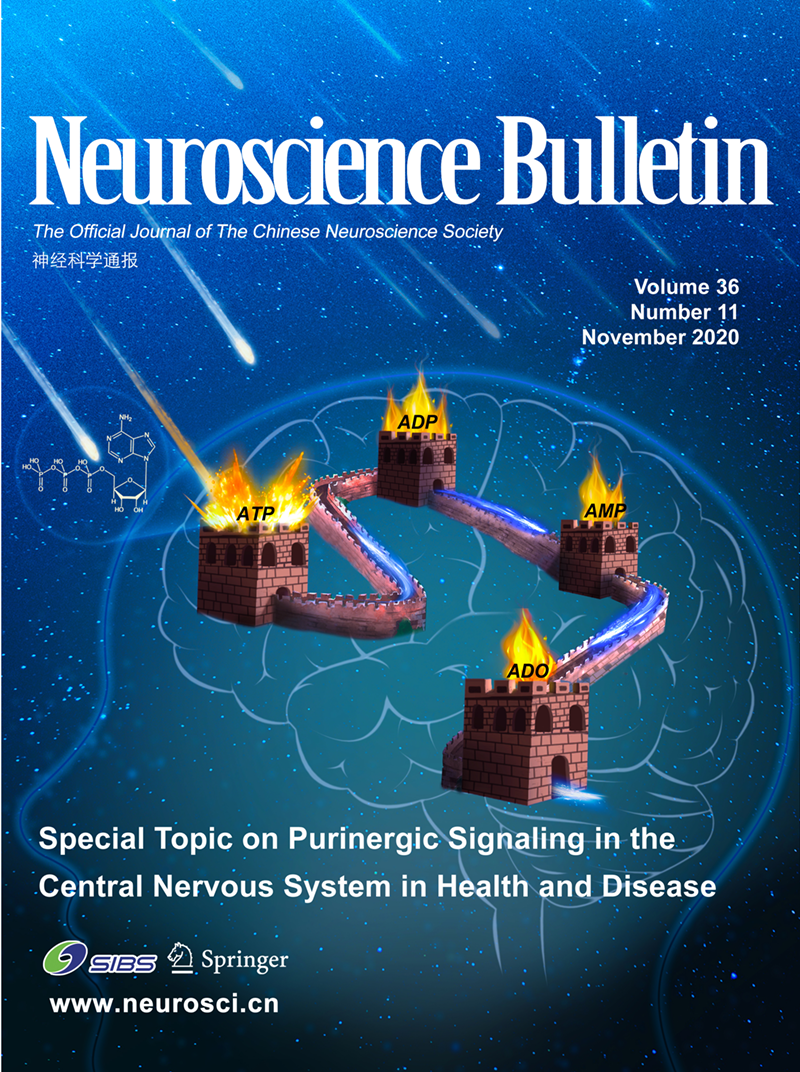Purinergic Signaling in the Central Nervous System in Health and Disease
Peter Illes • Guang-Yin Xu • Yong Tang
2020, 36(11): 1239-124 [
Abstract] [
SpringerLink]
[PDF]
Characterization of the Expression of the ATP-Gated P2X7 Receptor Following Status Epilepticus and during Epilepsy Using a P2X7-EGFP Reporter Mouse
James Morgan • Mariana Alves • Giorgia Conte • Aida Mene´ndez-Me´ndez• Laura de Diego-Garcia • Gioacchino de Leo • Edward Beamer • Jonathon Smith • Annette Nicke • Tobias Engel
2020, 36(11): 1242-1258 [
Abstract] [
SpringerLink]
[PDF]
Sleep Deprivation Selectively Down-Regulates Astrocytic 5-HT2BReceptors and Triggers Depressive-Like Behaviors via Stimulating P2X7 Receptors in Mice
Maosheng Xia • Zexiong Li • Shuai Li • Shanshan Liang • Xiaowei Li • Beina Chen • Manman Zhang• Chengyi Dong • Alexei Verkhratsky • Dawei Guan • Baoman Li
2020, 36(11): 1259-1270 [
Abstract] [
SpringerLink]
[PDF]
Adult Stress Promotes Purinergic Signaling to Induce Visceral Pain in Rats with Neonatal Maternal Deprivation
Shufen Hu • Qian Sun • Wan-Jie Du • Jian Song • Xin Li • Ping-An Zhang • Ji-Tian Xu • Guang-Yin Xu
2020, 36(11): 1271-1280 [
Abstract] [
SpringerLink]
[PDF]
Spinal CCL2 Promotes Pain Sensitization by Rapid Enhancement of NMDA-Induced Currents Through the ERK-GluN2B Pathway in Mouse Lamina II Neurons
Hui Zhang • Sui-Bin Ma• Yong-Jing Gao • Jun-Ling Xing • Hang Xian • Zhen-Zhen Li • Shu-Ning Shen • Sheng-Xi Wu • Ceng Luo • Rou-Gang Xie
2020, 36(11): 1344-1354 [
Abstract] [
SpringerLink]
[PDF]
Internal States Influence the Representation and Modulation of Food Intake by Subthalamic Neurons
Haichuan Wu • Xiang Yan• Dongliang Tang • Weixin Gu • Yiwen Luan• Haijiang Cai • Chunyi Zhou • Cheng Xiao
2020, 36(11): 1355-1368 [
Abstract] [
SpringerLink]
[PDF]
Relationship Between Hematoma Expansion Induced by Hypertension and Hyperglycemia and Blood–brain Barrier Disruption in Mice and Its Possible Mechanism: Role of Aquaporin-4 and Connexin43
Heling Chu • Zidan Gao • Chuyi Huang • Jing Dong • Yuping Tang • Qiang Dong
2020, 36(11): 1369-1380 [
Abstract] [
SpringerLink]
[PDF]
Whole-Brain Map of Long-Range Monosynaptic Inputs to Different Cell Types in the Amygdala of the Mouse
Jia-Yu Fu • Xiao-Dan Yu• Yi Zhu • Shi-Ze Xie • Meng-Yu Tang • Bin Yu • Xiao-Ming Li
2020, 36(11): 1381-1394 [
Abstract] [
SpringerLink]
[PDF]
Impact of Chronic Stress on Attention Control: Evidence from Behavioral and Event-Related Potential Analyses
Qingjin Liu • Yong Liu • Xuechen Leng • Jinfeng Han • Feng Xia • Hong Chen
2020, 36(11): 1395-1410 [
Abstract] [
SpringerLink]
[PDF]
Impaired ATP Release from Brain Astrocytes May be a Cause of Major Depression
Peter Illes • Patrizia Rubini • Haiyan Yin • Yong Tang
2020, 36(11): 1281-1284 [
Abstract] [
SpringerLink]
[PDF]
Purinergic Modulation of Activity in the Developing Auditory Pathway
Sasa Jovanovic• Ivan Milenkovic
2020, 36(11): 1285-1298 [
Abstract] [
SpringerLink]
[PDF]
Purinergic Receptors in Basal Ganglia Diseases: Shared Molecular Mechanisms between Huntington’s and Parkinson’s Disease
Talita Glaser• Roberta Andrejew• A ´ gatha Oliveira-Giacomelli•Deidiane Elisa Ribeiro• Lucas Bonfim Marques• Qing Ye• Wen-Jing Ren•Alexey Semyanov• Peter Illes• Yong Tang• Henning Ulrich
2020, 36(11): 1299-1314 [
Abstract] [
SpringerLink]
[PDF]
Purines: From Diagnostic Biomarkers to Therapeutic Agents in Brain Injury
Bruno G. Frenguelli • Nicholas Dale
2020, 36(11): 1315-1326 [
Abstract] [
SpringerLink]
[PDF]
Implication of Neuronal Versus Microglial P2X4 Receptors in Central Nervous System Disorders
Alexia Duveau • Ele´onore Bertin • Eric Boue´-Grabot
2020, 36(11): 1327-1343 [
Abstract] [
SpringerLink]
[PDF]

Purinergic signaling is recognized as a promising field in neuroscience. When the purinergic signal ATP is released from neurons, astrocytes, microglia, and oligodendrocytes, it immediately binds to its receptor or degenerates into the other purinergic signals ADP, AMP, and ADO to activate their receptors to act in a variety of physiological or pathological conditions in the central nervous system. The cover image illustrates that purinergic signaling is like an important star in the vast, borderless sky which represents profound neuroscience. ATP release is something like a meteor falling. When it falls at the first beacon tower in the Great Wall, ATP initiates the function of his place via binding to its receptor or breaks down very quickly to arrive at the second (ADP), third (AMP), and fourth (ADO) beacon towers to bind their own receptors and begin to work in the sulci and gyri along a meandering path. (Cover image provided by Yong Tang et al.)